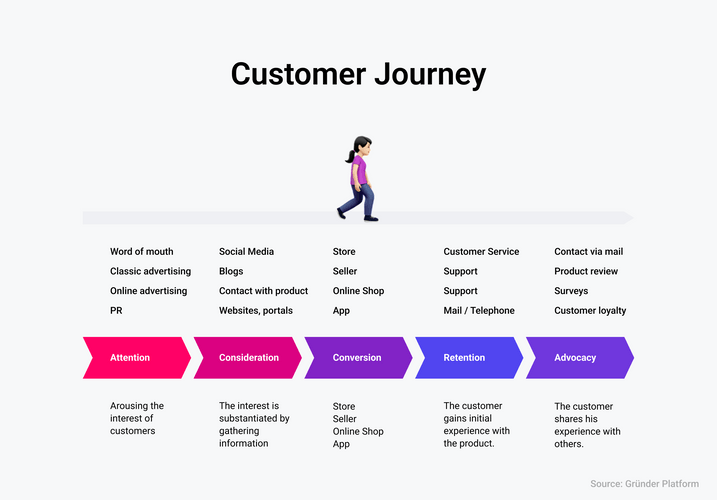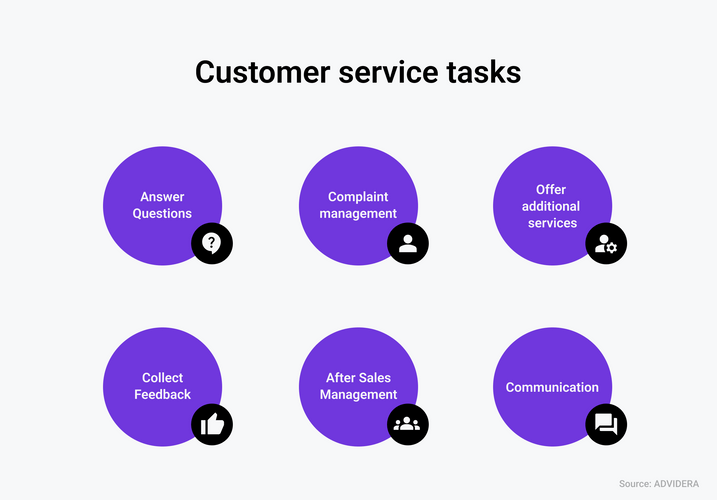Customer Service
How does customer service improve the customer journey?
Outstanding customer service improves the customer journey. We show how seamless interactions and personalized support increase customer loyalty and satisfaction.

Customer Journey definition
Customer Journey refers to the overall path a customer takes from the moment they become aware of a product or service, through the process of researching and considering it, to making a purchase and beyond. It is a representation of all the interactions a customer has with a company, from the initial contact to long-term customer retention.
The article in a nutshell…
Customer service plays a crucial role in the customer journey by influencing customer loyalty and retention. There are different phases of the customer journey: Awareness, Interest and Research, Selection and Purchase, Use and Experience, Feedback and Evaluation, Long-term Bonding.
Multichannel customer service: Companies can ensure they meet the needs of various customers and facilitate seamless interaction across all channels by providing customer service through various channels such as phone, email, live chat, and social media.
By customizing service offerings and communication, companies can address the specific needs and preferences of customers and build stronger bonds.
- 1Phases of the Customer Journey
- 2Strengthening customer retention with outstanding customer service
- 3What makes good customer service?
- 4Key factors in customer service
- 5Improving the Customer Journey through good customer service
- 6Multichannel customer service
- 7Personalization and customization in customer service
- 8Best Practices and Tips for an Optimized Customer Journey
- 9Ready to improve your customers' journey?
Phases of the Customer Journey
- Awareness Phase: The customer becomes aware of the product or service.
- Interest and Research: The customer begins to delve deeper into the product or service, gathering information and possibly comparing alternatives.
- Selection and Purchase: The customer makes a decision and completes a purchase.
- Use and Experience: After the purchase, the customer uses the product or service and experiences the customer service.
- Feedback and Evaluation: The customer provides feedback, either through direct communication or through reviews on social media or other platforms.
- Long-term Bonding: The company nurtures the relationship with the customer to promote long-term loyalty and potentially enable repeat business.

The different phases within the customer journey. Source: Gründerplattform
To optimize the customer experience and associated customer journey, there are various methods available. One of them is to accompany customers through efficient customer service, with a focus on retention.
Strengthening customer retention with outstanding customer service
Customer service is one of the most important components of the customer journey, as it contributes to customers feeling valued and well cared for. An optimal customer service…
- strengthens customer retention
- improves the customer experience
- meets customer expectations
Companies that invest their resources in both marketing and support can benefit enormously because customer service is also a form of marketing.
Customer support can extend beyond the purchase. For example, if customers have a question about a product after they have already purchased it, they return to the company and directly contact support.
Customer service doesn't abruptly stop; it always continues. Marketing and customer support are linked for me.Lars Schulze, UFOstart
In our 2021 Panel Discussion, we have already discussed the importance of support with marketing experts.
What makes good customer service?
The importance of customer service is often emphasized, but what components actually make up good service? The most important points are obvious:
- Speed
- Transparency
- Accessibility
- Clarity and simplicity
Customers expect quick answers, transparent communication, and solutions to be straightforward. Messages should not be too long and should not take long to respond to. Additionally, customer service ideally should always be accessible, whether it’s late at night, Sunday, or a holiday.
If a customer has a question, it should be answered as soon as possible!
Initially, these factors may sound simple and easy to implement, but they often pose significant challenges for companies.
Key factors in customer service
Good customer service must be maintained, which primarily requires a lot of time and money. Challenges in customer service include managing high customer expectations, effectively resolving complaints and conflicts, continuously training staff for complex inquiries, integrating technology to efficiently support customer service, and maintaining consistent service quality across various communication channels.

Customer service does not only ensure communication but has a lot of additional tasks to manage. Source: ADVIDERA
Improving the Customer Journey through good customer service
Improving the customer journey through good customer service can be achieved by seamless and positive interaction at various touchpoints, proactively identifying and fulfilling customer needs, offering personalized service tailored to the individual preferences and history of the customer, actively collecting and utilizing feedback to continuously optimize the service, providing efficient communication channels that allow easy accessibility and quick response, and supporting customers in case problems arise to ensure a positive experience.
The customer journey can be accompanied and supported by customer service from the beginning. This customer journey can be divided into different phases.
- Pre-Purchase Phase: Customer service can convince potential customers through good product advice and build trust with them. Answering questions, providing information, and assisting in decision-making are aspects that can be influenced by interacting with customer service even before the conscious purchase decision.
- Purchase Phase: Even in the purchase phase, support can assist customers by guiding them through the purchase process and eliminating any obstacles to facilitate the completion of the purchase.
- Post-Purchase Phase: After purchasing a product, customer service can proactively offer support, such as assistance with product setup, usage suggestions, etc.
In multichannel customer service, various customer needs can be addressed to provide optimal support for as many customers as possible.
Multichannel customer service
Der Multichannel-Kundenservice bezieht sich darauf, dass Unternehmen ihren Kundenservice über verschiedene Kommunikationskanäle anbieten. Das umfasst traditionelle Kanäle wie Telefon und E-Mail sowie moderne Optionen wie Live-Chat und soziale Medien.

Multichannel customer service with communication channels.
Multichannel customer service refers to companies offering their customer service through various communication channels. This includes traditional channels such as phone and email, as well as modern options like live chat and social media.
Email allows customers to send written inquiries and wait for a response, which is particularly convenient for non-urgent matters or for customers who prefer written communication.
Live chat provides customers with the opportunity to speak with a service representative in real-time, usually through the company’s website, apps, or messenger services. This option is especially useful for customers who need immediate answers or want to solve problems quickly without having to make a phone call.
Social media is also increasingly being used as a channel for customer service. Customers can ask questions or express complaints publicly, and companies can respond publicly or privately. This public interaction can also help strengthen the brand image and promote customer trust.
Another part of multichannel service is self-service. Customer self-service refers to a service option where customers are able to resolve their own inquiries, issues, or transactions without direct involvement of a service agent. This is often facilitated by providing tools such as FAQ pages, knowledge bases, online forms, or automated systems like chatbots or interactive voice response systems. This allows customers to find solutions independently.
Multichannel customer service aims to provide customers with greater choice and flexibility and ensure that they can receive service where they prefer to use it. Companies that successfully implement multichannel customer service can increase their accessibility, enhance customer satisfaction, and ultimately improve customer retention.
Personalization and customization in customer service
Personalization and customization in customer service are crucial strategies for building close relationships with customers and increasing their satisfaction. By tailoring service offerings, communication, and interactions, companies can effectively address the individual needs, preferences, and behaviors of their customers.
An important aspect of personalization is offering personalized communication channels and methods to provide a more individualized experience. This may include using preferred communication channels such as email, SMS, or social media or providing tailored content and offers across various channels.
Customization goes a step further by addressing not only current needs but also long-term goals and desires of customers. This means proactively reaching out to customers to support them in achieving their goals and offering solutions that meet their individual requirements.
Through targeted personalization and customization of customer service, companies can not only increase customer satisfaction and loyalty but also build a sustainable competitive position by offering a unique and distinctive experience that encourages customers to return and recommend the company to others.
Best Practices and Tips for an Optimized Customer Journey
To optimize customer service along the entire customer journey and increase customer satisfaction and loyalty, there are some best practices and tips that companies can follow.
An important approach is investing in training and development of customer service personnel. Employees should not only be well-informed about the product or service but also have excellent communication skills and empathy to effectively understand and meet customer needs.
Another best practice is implementing an efficient ticketing or case management system that allows companies to track, prioritize, and resolve customer inquiries and issues quickly and effectively. This ensures that no request is overlooked and customers receive timely support.
Continuous feedback from customers is also crucial. Companies should regularly gather feedback, whether through surveys, reviews, or direct customer feedback, to evaluate the quality of their customer service and identify opportunities for improvement.
The integration of technology can also help improve customer service. Implementing chatbots or automated systems can increase efficiency and allow customers to receive support around the clock. AI-powered analytics can also help understand customer behavior and preferences and offer personalized solutions.
Furthermore, it is important to provide a consistent and seamless experience across all customer service channels. Customers should experience the same quality and responsiveness regardless of whether they contact the company by phone, email, live chat, or social media.
Finally, companies should view customer service as an opportunity to build a long-term relationship with their customers. By proactively reaching out to customers, resolving issues quickly, and offering additional support, companies can gain the trust and loyalty of their customers and build long-term customer relationships.
By implementing these best practices and tips for optimized customer service along the entire customer journey, companies can not only increase customer satisfaction and loyalty but also promote a positive brand perception and sustainable success in the market.
Ready to improve your customers’ journey?
… then you can request a demo with us to discuss your specific use case and to show you our products. These can, for example, transform your customer service into a multichannel service and thus improve your customer satisfaction without much effort! We are also available for questions and suggestions.
